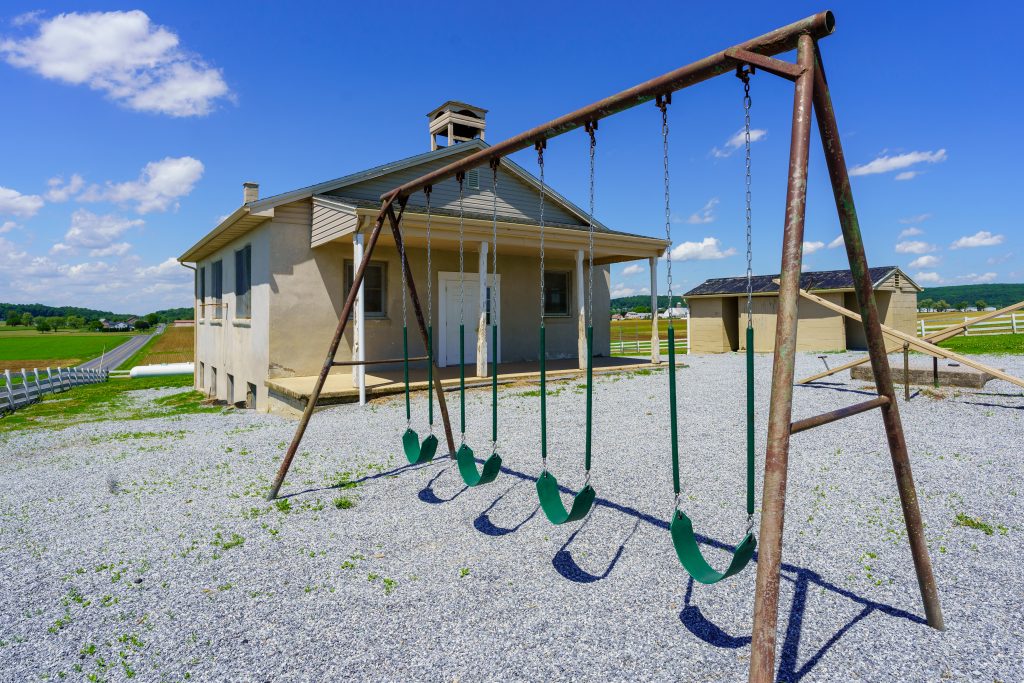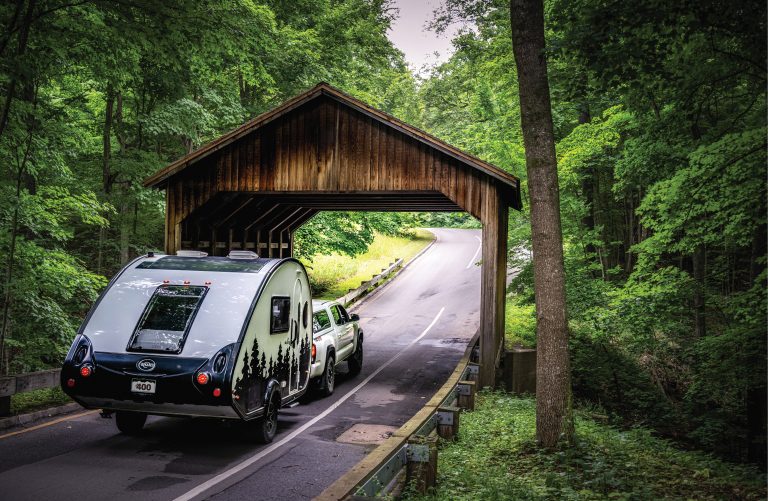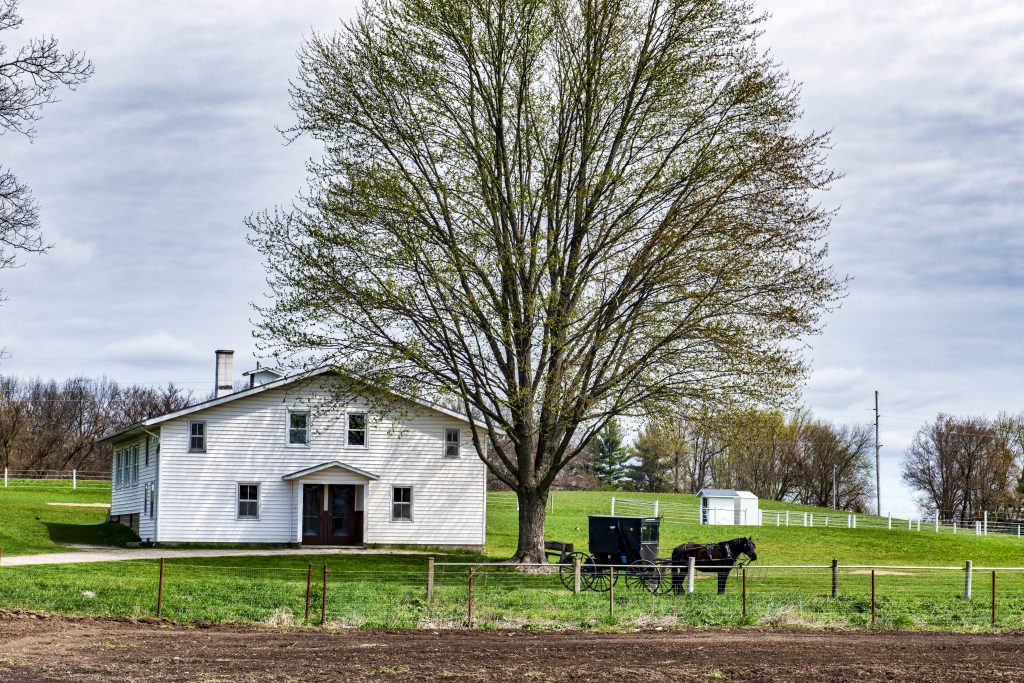nuCamp was established by Joe Mullet, who grew up in the Amish community in Sugarcreek, OH. The enduring values and traditions of the Amish have left an influential mark on nuCamp’s culture. Many of our production workers are Amish, and we are enthusiastic about sharing the rich history of Amish culture with our nuCamp family. In this series, titled “Our Amish Heritage,” Rebuen Shelter, a former nuCamp team member, shares a glimpse into the Amish way of life.
If you take a drive across Amish country, you will see small buildings scattered along the edges of farms or in random fields beside backroads. Some of the buildings will have a bell tower. Most of them will have a softball diamond, a set of swings, and a see-saw—and some will even have outhouses! You are seeing Amish schools—also called parochial schools.
Walking into an Amish parochial school is like stepping back in time. Most schools are one room, with desks facing the blackboard on the front wall. The majority of Amish schools have two teachers, with the eight grades split between the two. It’s typically up to the teachers to decide who will teach which grades. If the school is large, meaning it has thirty students or more, the teachers might have a helper (not an actual teacher, but a younger girl whose primary purpose is to help the youngest children).
School Operations
Amish teachers are usually girls—often ones who graduated a few years earlier. Some schools might have male teachers, but on average, they will be two 17–20-year-old girls. The school is governed by a board of three men, elected from among and by the parents. Each board member serves three years, making his way to the top, the “head-board man.” Then he steps down, usually not needing to serve another term if there are enough other parents in the school.
Any school father is eligible to be voted onto the board, with two exceptions: No one votes for ministers (they’re busy with that calling), and no one votes for the treasurer. The treasurer often remains treasurer for as long as his children are in school, sometimes even longer.
The Amish started this school system in the 1930s. At first, they received opposition from the United States government. The Wisconsin v. Yoder case in 1972 finally gave them the freedom to operate their school system because of their religious beliefs. The schools are supposed to be an arm of the church. That’s where the name “parochial” comes from. Parochial means: “of or relating to a church parish.” The borders of the school districts are often established by the borders of different church districts.
Amish education consists of a few weeks of kindergarten, then it continues from first through eighth grade. At the end of eighth grade, a student is considered a graduate. The Amish do not want their children to attend high school or college. In fact, it’s against the Ordnung (rules to live by) of the church. The Amish believe it is spiritually safer for children to begin working at age fifteen rather than to continue to attend school and face peer pressure in high school and college. Therefore, Amish children will never get jobs that require a college degree. But they will learn to be dependable, self-sufficient, and hardworking at a younger age.

School Happenings
At 8:00 in the morning, the backroads of Amish country are filled with pony carts, bicycles, scooters, and children walking. Most Amish students live within a mile or two of their school. It is not uncommon for the children to arrive early and play on the playground for a while until the bell rings. Then school begins!
An Amish school day usually begins with a Bible story; then, there are lessons like any other school. The difference is the different grades must take turns going up front and reciting their lessons to the teachers, just like all schools did long ago.
A highlight is the “hot lunch.” That’s when two mothers — usually once a month — bring lunch for the school. The children always look forward to the break in the routine. And sometimes the mothers bring candy.
Visitors are also not uncommon at school. Most parents try to visit the school at least once during the term. They’ll sit in the back and watch the goings-on. Often, they’ll bring a treat, such as candy, cupcakes, or popsicles. Some teachers will have the students sing for the visitors.
Once every six weeks, there is a parent/teacher meeting. All the parents meet at the school in the evening to talk briefly with the board and teachers to ensure everything is going well. If there are problems, here is when they are addressed. Most Amish parents and teachers are transparent and willing to work out issues. But they are all human, and sometimes problems arise that take some time to resolve! That’s when the board, the ultimate authority of the school, has to get involved.
Some Amish schools have a back-to-school hotdog supper at the school for the parents, teachers, and students about a week before school starts. Then, a week or so after school ends, they all gather at the school on a Saturday for a picnic. That is when the ball games happen.
The biggest and most lively competition is when the fathers play the schoolchildren. It is every student’s wish to be on that team that defeats the fathers. The students rarely win, but it does happen.
Memorable holidays
The Thanksgiving singing and the Christmas program are two more memorable parts of an Amish school term. Our school had its Thanksgiving singing just last week. All the parents arrived at the school by 6:30 in the evening. Then, the children sat around a circle of tables and sang four songs for the parents. After that, songbooks were passed out to the parents, and we joined in the singing as well. We sang for over an hour in that small schoolroom and almost lifted the ceiling as we voiced our praise. Then, the snacks that the mothers had brought along were uncovered, and we ended the evening on a satisfied note.
The Christmas program is the highlight of almost every Amish child’s school year. The students begin practicing in November — virtually every day. When the long-awaited event rolls around in late December, all the children from first to eighth grade know their lines by heart.
Amish schools have their programs twice on the same day. The first program is in the morning, for those who will not be able to attend the one in the evening. But the program in the evening is what everyone has been waiting for. Parents, grandparents, friends, and neighbors arrive in a wave of buggies, bicycles, and taxi vehicles. The little schoolhouse is decorated to a magnificent splendor. Tinsel hangs on the wall, paper snowflakes from the ceiling. Candles twinkle in every window. On the blackboard, in beautifully-lettered calligraphy, are the words: “For Christ is born in Bethlehem.”
The guests sit on wooden benches in the schoolroom that have been cleared of desks. Against the wall, there is a wooden stage constructed by the school board. Curtains surround it.
When the time arrives, the teachers slide the curtains to the side. Twenty beaming children stand on the stage and burst into song the instant they see their parents’ faces. The Christmas program is on!
The program lasts for about an hour and a half, consisting of singing, skits, poems, and — always — a manger scene. It’s a young child’s dream come true to be Joseph, or Mary, or a shepherd, or a sheep. And then, after the program is over, there is still another highlight. Gifts! The students exchanged names in November, and now, with the parents watching, they give each other their gifts. At the count of three, they all rip the gifts open at the same time. The evening is completed by the parents giving gifts to the teachers. The parents all contribute money to buy something significant for the teachers — something they’ll be able to use for the rest of their lives.
A simplistic approach
Such is life at an Amish school. Most of the events and rituals are simplistic, like almost everything else in the Amish lifestyle. But if you ask the students, they say they wouldn’t want it any other way.
One response to “Our Amish Heritage: An Amish School Year”
Recent Articles






This is a wonderful insight and I must say very inspiring. I like it. Thanks for sharing. God bless.